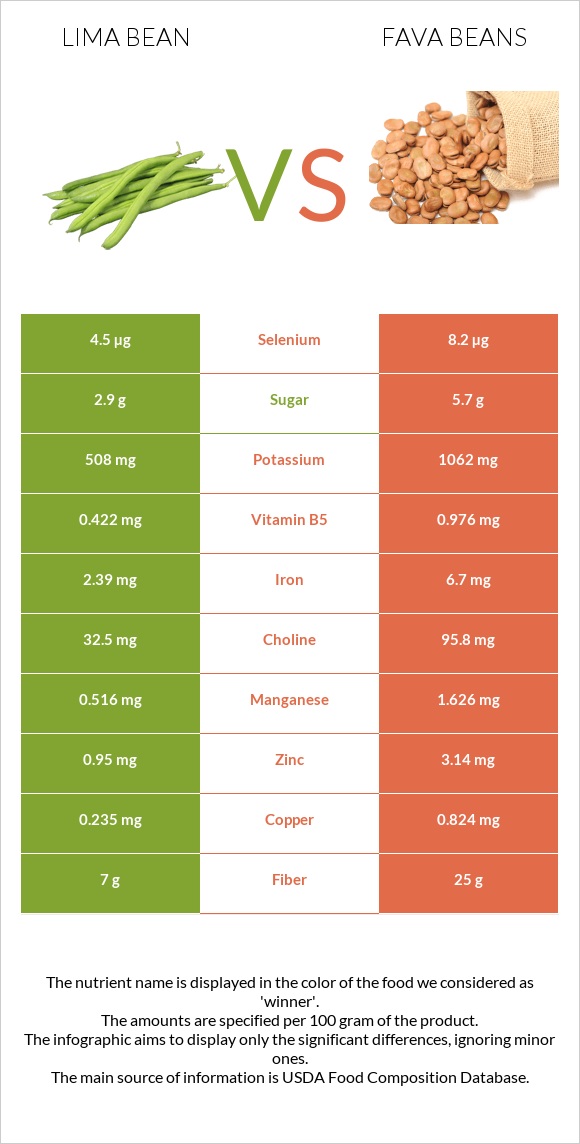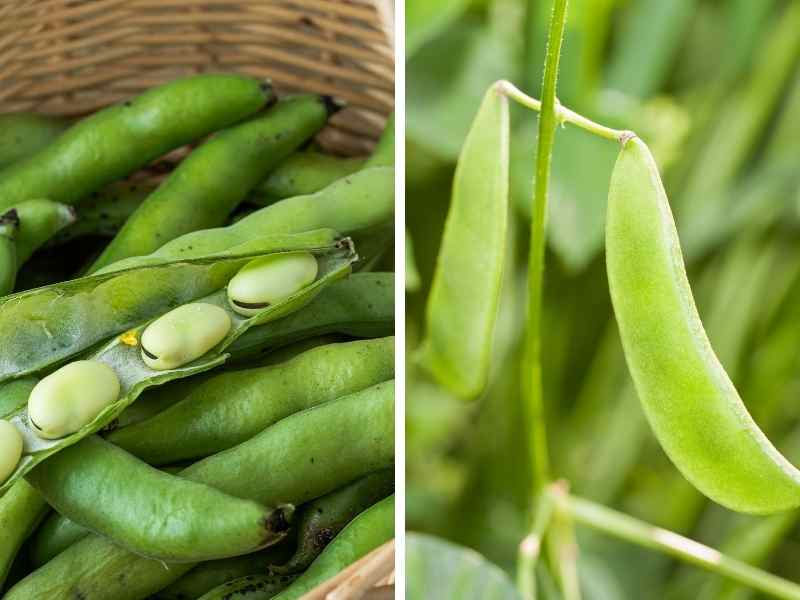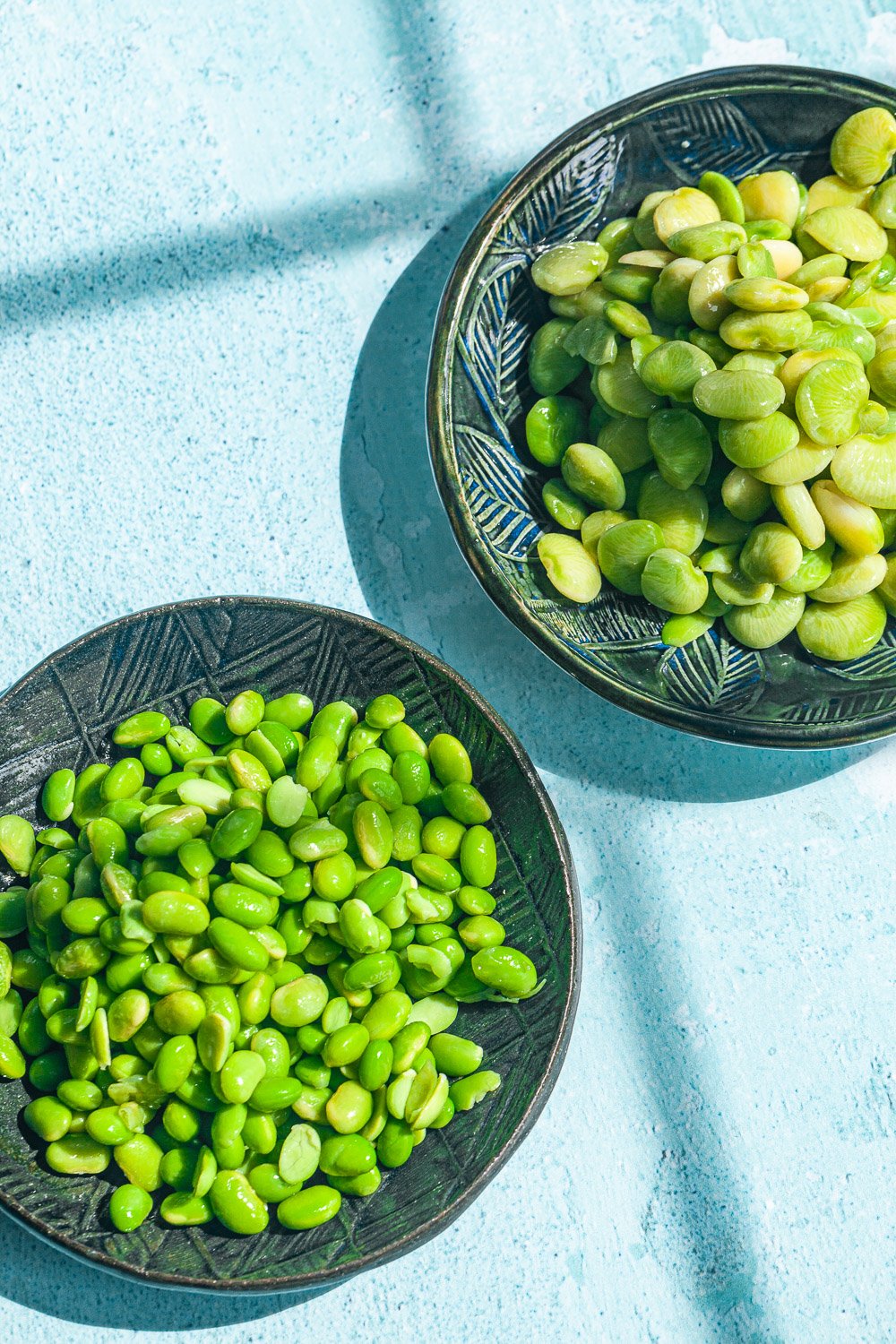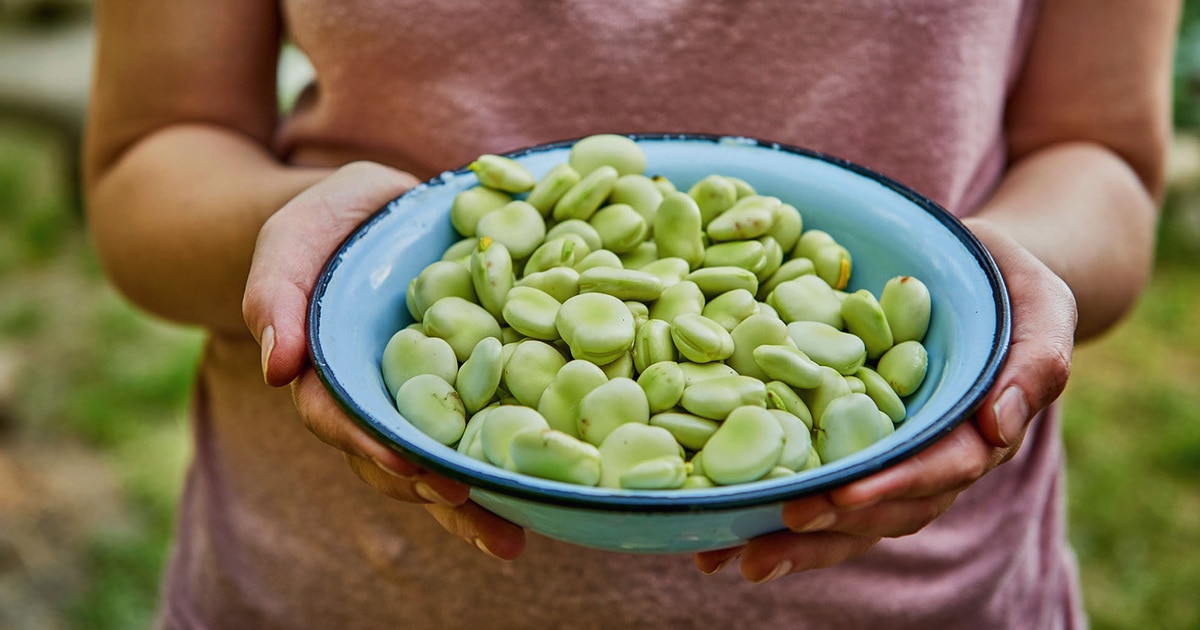Introduction

In the world of legumes, Lima beans and Fava beans are two popular choices that offer distinct flavors, textures, and nutritional profiles. While they may seem similar at first glance, understanding their differences is essential for enhancing your cooking experience and incorporating variety into your meals. Lima beans, also known as butter beans, have a delicate taste and creamy texture, while Fava beans, also called broad beans, have a more earthy flavor and larger size. This article will delve into the origins, culinary uses, and nutritional benefits of both legumes, allowing you to make informed choices in your culinary creations.
Overview Of Lima Beans And Fava Beans
Lima beans and Fava beans are two legume varieties with their own unique characteristics. Lima beans, also known as butter beans, are small, flat, and kidney-shaped. They have a delicate taste and a creamy texture, making them a popular choice in soups, stews, and salads. On the other hand, Fava beans, also called broad beans, are larger, flat, and oval-shaped. They have a more earthy flavor and a firm texture, making them well-suited for dishes like falafel, dips, and stir-fries. Despite their differences, both legumes are nutritious and offer various health benefits.
Nutritional Content And Health Benefits
Both Lima Beans and Fava Beans are nutritional powerhouses that offer a range of health benefits. Lima Beans are packed with fiber, protein, and essential nutrients like potassium, magnesium, and folate. These nutrients support digestive health, improve heart health, and boost the immune system. Moreover, the high fiber content of Lima Beans aids in weight management and promotes satiety. On the other hand, Fava Beans are rich in iron, which is essential for transporting oxygen in the body. They also contain vitamins A, C, and K, as well as antioxidants that promote overall health and protect against chronic diseases. Incorporating both Lima Beans and Fava Beans into your diet can contribute to a well-rounded and nutritious meal plan.
Lima Beans

Lima Beans, also known as butter beans, are small, flat, and kidney-shaped legumes that are widely enjoyed for their delicate taste and creamy texture. They have a mild flavor that pairs well with a variety of other ingredients, making them a versatile addition to many dishes. Lima beans are not only delicious, but they are also packed with nutritional benefits. They are an excellent source of fiber, protein, potassium, magnesium, and folate. Incorporating Lima beans into your diet can support digestive health, improve heart health, boost the immune system, and aid in weight management.
Lima Beans: Origin And Cultivation
Lima beans, also known as butter beans, have been cultivated and consumed for centuries. They are believed to have originated in South America, specifically in the region we now know as Peru. The Incas were the first to cultivate and appreciate these beans for their nutritional value. From there, their popularity spread to other parts of the world, including Europe and Africa. Today, Lima beans are grown in various countries, including the United States, Peru, India, and China. They thrive in warm climates and are usually planted in the spring, with the beans ready for harvest in late summer or early fall. Lima beans require well-drained soil and regular watering to ensure healthy growth. Their cultivation has been successful due to their adaptability and ability to thrive in different environments.
Lima Beans: Cooking Methods And Flavor Profile
Lima beans are incredibly versatile and can be prepared in a variety of ways to suit different tastes and preferences. They can be boiled, steamed, sautéed, or even roasted to bring out their delicious flavors. When cooked, Lima beans have a delicate and buttery taste, with a slightly nutty undertone. This mild flavor allows them to absorb other flavors easily, making them a perfect addition to soups, stews, and casseroles. They also make a great side dish when seasoned with herbs, garlic, and a drizzle of olive oil. Whether enjoyed on their own or mixed with other ingredients, Lima beans provide a creamy and satisfying texture that can complement a wide range of dishes.
Fava Beans

Fava beans, also known as broad beans, have a rich and complex flavor profile that sets them apart from other legumes. These large, flat beans have an earthy taste with hints of nuttiness. They are often described as having a slightly sweet and savory flavor that is both satisfying and unique. Fava beans have a buttery texture that adds richness to any dish they are incorporated into. They are a versatile ingredient that can be used in a variety of culinary creations, from soups and stews to salads and side dishes. Fava beans are not only delicious, but they also offer a range of nutritional benefits, making them a great addition to a healthy diet.
Fava Beans: Historical Significance
Fava beans have a long and storied history, dating back thousands of years. They have been cultivated and consumed in various parts of the world since ancient times. In fact, fava beans are believed to be one of the oldest cultivated crops, with evidence of their existence found in archaeological sites in the Middle East and Mediterranean regions. Fava beans were highly prized by the ancient Egyptians, Greeks, and Romans, who considered them to be a symbol of fertility and good luck. They were also used as offerings to the gods in religious ceremonies. Today, fava beans continue to be enjoyed in many cuisines around the world, showcasing their enduring popularity and significance throughout history.
Fava Beans: Culinary Uses And Unique Characteristics
Fava beans have a number of unique characteristics that make them a versatile ingredient in various cuisines around the world. Their earthy flavor and buttery texture lend themselves well to a wide range of dishes. Fava beans can be enjoyed in both cooked and raw forms. In some cultures, the beans are eaten raw, either on their own or added to salads. In other cuisines, they are often cooked and used in soups, stews, and pasta dishes. Fava bean puree, known as ful medames, is a popular dish in Middle Eastern cuisine. Additionally, fava beans can be roasted, mashed, or added to risottos, creating rich and flavorful dishes. Their unique taste and versatility make fava beans a valuable ingredient in the kitchen.
Nutritional Comparison

When comparing the nutritional content of Lima Beans and Fava Beans, both legumes have their own unique set of benefits. Lima beans are an excellent source of dietary fiber, protein, and essential minerals such as potassium and magnesium. Fava beans, on the other hand, are packed with protein, iron, and folate, making them a great choice for vegetarians and vegans. Additionally, Fava beans are low in fat and cholesterol, making them a heart-healthy option. Incorporating both Lima beans and Fava beans into your diet can provide a range of essential nutrients and contribute to a balanced and nutritious meal plan.
Comparing The Nutritional Value Of Lima Beans And Fava Beans
Lima Beans and Fava Beans are both powerhouse legumes when it comes to nutrition. While Lima Beans are known for their high dietary fiber content and abundance of essential minerals like potassium and magnesium, Fava Beans offer an impressive amount of protein, iron, and folate. Both beans are low in fat and cholesterol, making them heart-healthy choices. When it comes to comparing the two, Lima Beans have slightly higher fiber content, while Fava Beans take the lead in terms of protein and iron. Incorporating both of these legumes into your diet ensures a diverse range of essential nutrients.
Health Benefits Of Incorporating Both Legumes In Your Diet
Incorporating both Lima Beans and Fava Beans into your diet can offer a wide range of health benefits. Lima Beans are rich in dietary fiber, which aids in digestion and promotes a feeling of fullness, making it beneficial for weight management. They also contain essential minerals like potassium and magnesium, which help regulate blood pressure and support muscle function. Fava Beans, on the other hand, are packed with protein, iron, and folate, which are important for growth, oxygen transportation, and cell development. Additionally, both legumes are low in fat and cholesterol, making them heart-healthy choices. By including a variety of legumes in your diet, you can enjoy these nutritional benefits and improve your overall health.
Cooking Tips And Recipes

When it comes to cooking Lima beans and Fava beans, there are a few tips and tricks you can follow to enhance their flavor and texture. Here are some cooking tips to help you make delicious dishes with these legumes:
- Soaking: Before cooking, it is recommended to soak both Lima beans and Fava beans in water overnight. This helps to reduce cooking time and improve digestibility.
- Boiling: To cook Lima beans and Fava beans, boil them in salted water until they are tender. This usually takes around 15-20 minutes for Lima beans and 25-30 minutes for Fava beans.
- Seasoning: Both legumes can be flavored with various herbs and spices to enhance their taste. Add garlic, onions, or herbs like rosemary, thyme, and parsley while cooking to infuse the beans with a delicious aroma.
Now, let’s move on to some recipes that you can try using Lima beans and Fava beans:
- Lima Bean Salad: Mix cooked Lima beans with diced tomatoes, cucumber, red onion, and feta cheese. Drizzle with olive oil and lemon juice for a refreshing and nutritious salad.
- Fava Bean Dip: Blend cooked Fava beans with garlic, lemon juice, olive oil, and tahini to make a creamy and flavorful dip. Serve it with pita bread or fresh vegetables.
- Moroccan Tagine with Fava Beans: Cook Fava beans with diced vegetables, spices like cumin, turmeric, and paprika, and vegetable broth. Serve it over couscous or rice for a hearty and exotic meal.
Remember to get creative with your cooking and experiment with different flavors and ingredients to make these legumes even more exciting in your meals. Enjoy the versatility and health benefits of Lima beans and Fava beans in your culinary creations!
Delicious Recipes Using Lima Beans And Fava Beans
Lima beans and Fava beans can be transformed into delicious and nutritious dishes that will satisfy your taste buds. Here are some mouthwatering recipes to try with these legumes:
- Lima Bean Salad: Combine cooked Lima beans with diced tomatoes, cucumber, red onion, and feta cheese. Drizzle with olive oil and lemon juice for a refreshing and healthy salad.
- Fava Bean Dip: Blend cooked Fava beans with garlic, lemon juice, olive oil, and tahini to create a creamy and flavorful dip. Serve it with pita bread or fresh vegetables for a tasty appetizer.
- Moroccan Tagine with Fava Beans: Cook Fava beans with diced vegetables, aromatic spices like cumin, turmeric, and paprika, and vegetable broth. Serve it over couscous or rice for a hearty and exotic meal.
These recipes showcase the versatility of Lima beans and Fava beans, allowing you to explore new flavors and textures in your culinary creations. Enjoy the deliciousness and nutritious benefits of these legumes in your next meal!
Cooking Tips To Enhance The Flavor And Texture Of Each Legume
To bring out the best flavors and textures of Lima beans and Fava beans, here are some cooking tips to consider. For Lima beans, try soaking them overnight before cooking to soften their texture. This will also reduce cooking time. To enhance their mild flavor, consider adding ingredients like garlic, herbs, or bacon during the cooking process. Lima beans also pair well with acidic ingredients like tomatoes or lemon juice, which can help balance their richness.
When it comes to Fava beans, blanching them in boiling water for a few minutes and then peeling off the outer skin can improve their texture and remove any bitterness. Fava beans are versatile and can be used in salads, purees, or stews. To enhance their earthy flavor, add ingredients like onions, garlic, or herbs like thyme or rosemary. Fava beans also work well with bold flavors like cumin or smoked paprika.
Whether you choose Lima beans or Fava beans, these cooking tips will elevate their taste and ensure a delightful culinary experience.
Conclusion

In conclusion, both Lima beans and Fava beans offer unique flavors and nutritional benefits. Lima beans are mild and creamy, while Fava beans have a rich and earthy taste. Incorporating these legumes into your diet can provide an array of vitamins, minerals, and plant-based protein. Whether you choose to enjoy Lima beans in soups or salads, or use Fava beans in stews or purees, both legumes have their place in the culinary world. So, consider adding these versatile and nutritious beans to your meals and explore the delicious possibilities they offer.
Key Takeaways On Lima Beans Vs Fava Beans
Both Lima beans and Fava beans offer unique flavors and nutritional benefits. Lima beans are mild and creamy, while Fava beans have a rich and earthy taste. Incorporating these legumes into your diet can provide an array of vitamins, minerals, and plant-based protein. Whether you choose to enjoy Lima beans in soups or salads, or use Fava beans in stews or purees, both legumes have their place in the culinary world. So, consider adding these versatile and nutritious beans to your meals and explore the delicious possibilities they offer.
Choosing The Right Legume For Your Culinary Creations
When it comes to choosing the right legume for your culinary creations, both Lima beans and Fava beans have their own unique qualities to offer. If you’re looking for a milder and creamier taste, Lima beans are the way to go. They work well in salads, soups, and side dishes. On the other hand, if you want a richer and earthier flavor, Fava beans are perfect for stews, purees, and dips. Consider the dish you’re preparing and the flavors you want to highlight, and let that guide your decision. Whichever legume you choose, you can’t go wrong with these versatile and nutritious options that will add depth and flavor to your meals.
FAQ About Lima Beans Vs Fava Beans: Exploring Two Legume Varieties
Q: What are the main differences between Lima Beans and Fava Beans?
A: Lima beans tend to be smaller and smoother in texture compared to the larger, flat shape and buttery texture of fava beans. Lima beans have a buttery flavor, whereas fava beans have a slightly nutty taste.
Q: How do you cook Lima Beans and Fava Beans differently?
A: Lima beans are often boiled or steamed and used in soups, stews, or salads, while fava beans are commonly blanched, peeled, and can be grilled, sautéed, or pureed for dishes like falafel or hummus.
Q: Are Lima Beans and Fava Beans equally nutritious?
A: Both Lima Beans and Fava Beans are rich in protein, fiber, and various vitamins and minerals, but fava beans are slightly higher in protein content while Lima beans contain more folate.
Q: Can Lima Beans and Fava Beans be used interchangeably in recipes?
A: While both beans are versatile, they have distinct flavors and textures, so they may not always be suitable substitutes for each other. It’s best to choose the bean that complements the dish you are preparing.
Q: Are Lima Beans and Fava Beans easy to grow in home gardens?
A: Both Lima Beans and Fava Beans are relatively easy to grow at home. Lima beans prefer warm temperatures, while fava beans thrive in cooler climates. They both require well-drained soil and regular watering.
Q: Are Lima Beans and Fava Beans safe for everyone to consume?
A: While Lima Beans and Fava Beans are nutritious, some individuals may be allergic to legumes like fava beans. It’s advisable to consult a healthcare provider before consuming these beans if you have food allergies.

The Bird ‘n’ Bike Cafe ‘n’ Bar is a charming establishment nestled in the heart of Chiltern, Victoria, where locals and visitors alike come together to enjoy delicious food, great company, and a warm, welcoming atmosphere. With 1187 likes and 136 check-ins, it’s clear that the Bird ‘n’ Bike has captured the hearts of many. Our cafe and Bar is open from Wednesday to Sunday, inviting guests to start their day with us from 8 am to 2:30 pm. Whether you prefer to dine in and savor the cozy ambiance or grab a delicious meal, we’ve got you covered.